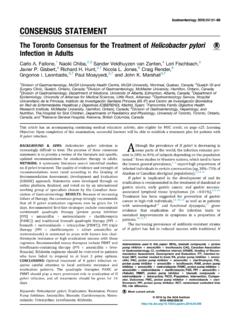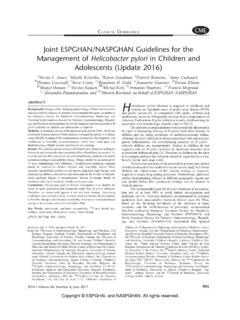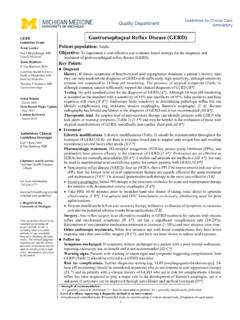Transcription of Test and treat for Helicobacter pylori - GOV.UK
1 Test and treat for Helicobacter pylori (HP) in dyspepsia Quick reference guide for primary care: For consultation and local adaptationTest and treat for Helicobacter pylori (HP) in dyspepsia Quick reference guide for primary care: For consultation and local adaptation 2 Produced: 2004 - Latest Review: July 2017 Updated: August 2019 - Next Full Review: October 2019 About Public Health England Public Health England exists to protect and improve the nation s health and wellbeing, and reduce health inequalities. We do this through world-leading science, research, knowledge and intelligence, advocacy, partnerships and the delivery of specialist public health services.
2 We are an executive agency of the Department of Health and Social Care, and a distinct delivery organisation with operational autonomy. We provide government, local government, the NHS, Parliament, industry and the public with evidence-based professional, scientific and delivery expertise and support. Public Health England Wellington House 133-155 Waterloo Road London SE1 8UG Tel: 020 7654 8000 Twitter: @PHE_uk Facebook: Prepared by: Professor Cliodna McNulty For queries relating to this document, please contact Crown copyright 2017 You may re-use this information (excluding logos) free of charge in any format or medium, under the terms of the Open Government License To view this license, visit OGL or email Where we have identified any third party copyright information you will need to obtain permission from the copyright holders concerned.
3 Any enquiries regarding this publication should be sent to Published July 2017 PHE publications gateway number: GW-684 This document is available in other formats on request. Please call 0300 422 5068 or email Test and treat for Helicobacter pylori (HP) in dyspepsia Quick reference guide for primary care: For consultation and local adaptation 3 Produced: 2004 - Latest Review: July 2017 Updated: August 2019 - Next Full Review: October 2019 Contents About Public Health England 2 Contents 3 Foreword Aims and adaptations 4 Quick reference guide 5 References and rationale 8 Acknowledgements 22 Abbreviations 25 Test and treat for Helicobacter pylori (HP) in dyspepsia Quick reference guide for primary care: For consultation and local adaptation 4 Produced: 2004 - Latest Review: July 2017 Updated: August 2019 - Next Full Review.
4 October 2019 Foreword Aims and adaptations Audience primary care prescribers in general practice and out of hours settings; including doctors, nurses and pharmacists those giving first point of contact for test and treat of Helicobacter pylori in adults Aims to provide a simple, effective, economical and empirical approach to the test and treat of Helicobacter pylori to minimise the emergence of antibiotic resistance in the community Implications the guidance should lead to more appropriate antibiotic use use of this guidance may influence laboratory workload.
5 Which may have financial implications for laboratories and primary care commissioners Production the guidance has been produced in consultation with the Association of Medical Microbiologists, general practitioners, nurses, specialists, and patient representatives the guidance is in agreement with other publications, including CKS, SIGN and NICE the guidance is fully referenced and graded the guidance is not all-encompassing, as it is meant to be quick reference if more detail is required we suggest referral to the websites and references cited the guidance will be updated every three years.
6 Or more frequently if there are significant developments in the field Poster Presentation of Guidance the summary table is designed to be printed out as a poster for use in practice the rationale and evidence is designed to be used as an educational tool for you, and your colleagues and trainees, to share with patients as needed Local Adaptation we would discourage major changes to the guidance, but the format allows minor changes to suit local service delivery and sampling protocols to create ownership agreement on the guidance locally, dissemination should be agreed and planned at the local level between primary care clinicians, laboratories and secondary care providers We welcome opinions on the advice given.
7 Please email any evidence or references that support your requests for change so that we may consider them at our annual review. Comments should be submitted to Professor Cliodna McNulty, Head of PHE Primary Care Unit, Microbiology Laboratory, Gloucestershire Royal Hospital, Great Western Road, Gloucester GL1 3NN. Email: Test and treat for Helicobacter pylori (HP) in dyspepsia Quick reference guide for primary care: For consultation and local adaptation 5 Produced: 2004 - Latest Review: July 2017 Updated: August 2019 - Next Full Review: October 2019 Quick reference guide NICE Patients over the age of 55, with recent onset, unexplained and persistent dyspepsia (over 4-6 weeks) should be referred urgently for endoscopy to exclude WHEN SHOULD I TEST FOR Helicobacter pylori ?
8 Patients with uncomplicated dyspepsia unresponsive to lifestyle change and antacids, following a single one month course of proton pump inhibitor (PPI), without alarm ,3A-,4A-,5A-,6A- Note: Options should be discussed with patients, as the prevalence of HP in developed countries is falling,7B+,8B-,9B+ and is lower than 15% in many areas in the +,11D A trial of PPI should usually be prescribed before testing, unless the likelihood of HP is higher than 20%11A- (older people; people of North African ethnicity;8B-,9B+ those living in a known high risk area), in which case the patient should have a test for HP first, or in parallel with a course of PPI.
9 Patients with a history of gastric or duodenal ulcer/bleed who have not previously been Patients before taking NSAIDs, if they have a prior history of gastro-duodenal ulcers/bleeds. Note: Both HP and NSAIDs are independent risk factors for peptic ulcers, so eradication will not remove all Patients with unexplained iron-deficiency anaemia, after negative endoscopic investigation has excluded gastric and colonic malignancy, and investigations have been carried out for other causes, including: cancer; idiopathic thrombocytopenic purpura; vitamin B12 WHEN SHOULD I NOT TEST FOR Helicobacter pylori ?
10 Patients with proven oesophagitis, or predominant symptoms of reflux, suggesting gastro-oesophageal reflux disease (GORD).2D,11D,12A+ Children with functional +,14A+ WHICH NON-INVASIVE TEST SHOULD BE USED IN UNCOMPLICATED DYSPEPSIA? Urea breath tests (UBTs)15A+,16C,17B+ and stool antigen tests (SATs) are the preferred + WHEN SHOULD I treat Helicobacter pylori ? Urea Breath Test (UBT): most accurate ,15A+,16C,17B+ needs a prescription and staff time to perform Stool Helicobacter Antigen Test (SAT): check test +,19A+ pea-sized piece of stool sent to local laboratory Serology: whole blood in plain bottle; low cost, lower ,16A-,23A+ not recommended for most patients, and positives should be confirmed by a second test such as UBT, SAT24D or biopsy11D,15A+ has very good negative predictive value at current.













